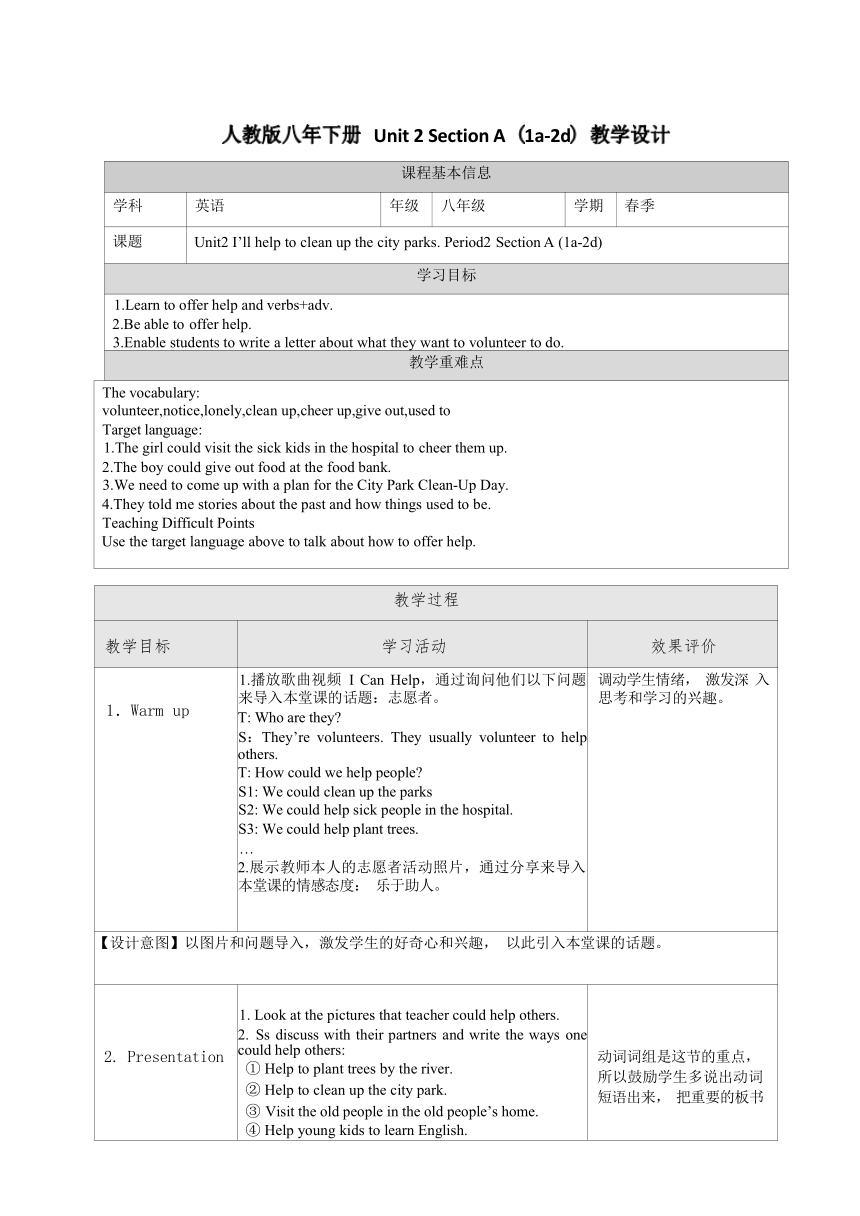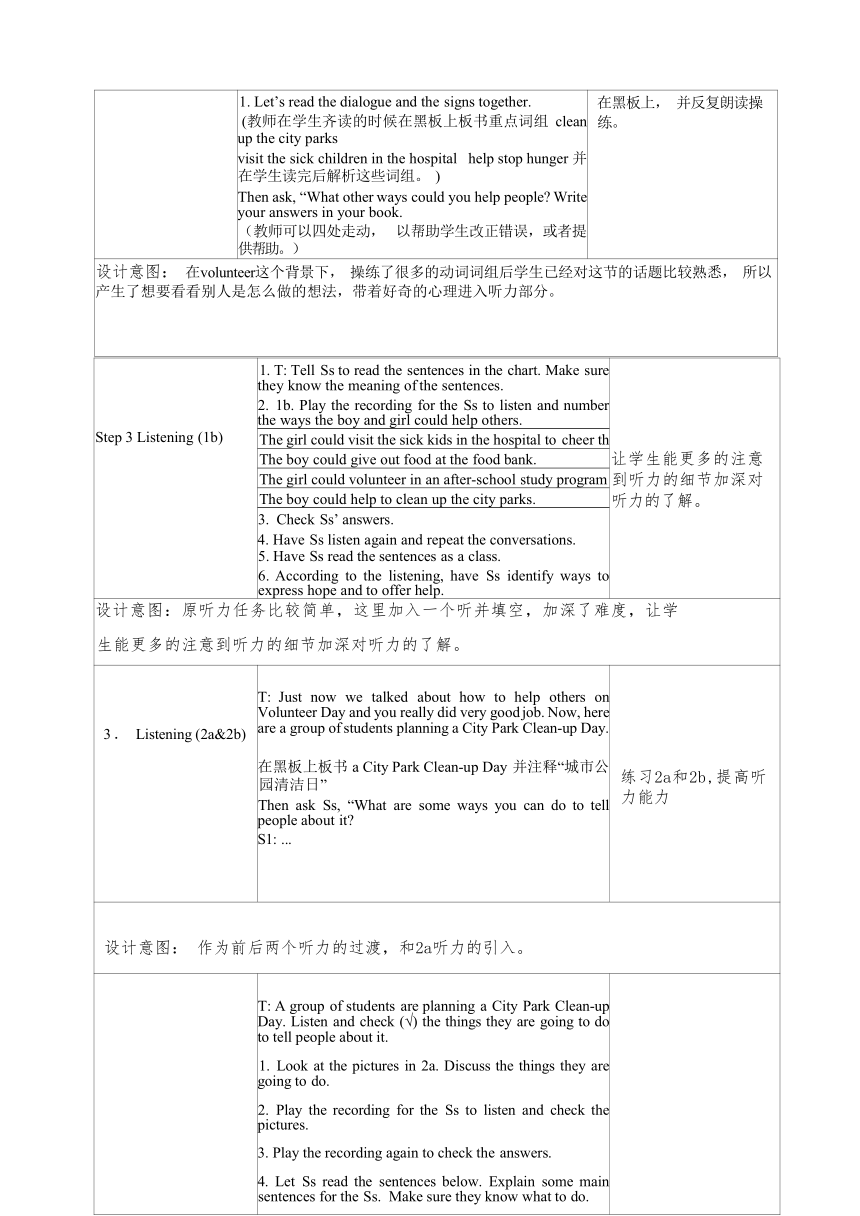人教版八年级下册Unit 2 I’ll help to clean up the city parks Section A (1a-2d) 教学设计(表格式)
文档属性
| 名称 | 人教版八年级下册Unit 2 I’ll help to clean up the city parks Section A (1a-2d) 教学设计(表格式) |  | |
| 格式 | docx | ||
| 文件大小 | 41.3KB | ||
| 资源类型 | 教案 | ||
| 版本资源 | 人教新目标(Go for it)版 | ||
| 科目 | 英语 | ||
| 更新时间 | 2024-03-24 18:25:16 | ||
图片预览



文档简介
Unit 2 Section A 1a-2d
课程基本信息
学科 英语 年级 八年级 学期 春季
课题 Unit2 I’ll help to clean up the city parks. Period2 Section A (1a-2d)
学习目标
1.Learn to offer help and verbs+adv. 2.Be able to offer help. 3.Enable students to write a letter about what they want to volunteer to do.
教学重难点
The vocabulary: volunteer,notice,lonely,clean up,cheer up,give out,used to Target language: 1.The girl could visit the sick kids in the hospital to cheer them up. 2.The boy could give out food at the food bank. 3.We need to come up with a plan for the City Park Clean-Up Day. 4.They told me stories about the past and how things used to be. Teaching Difficult Points Use the target language above to talk about how to offer help.
教学过程
教学目标 学习活动 效果评价
1.Warm up 1.播放歌曲视频 I Can Help,通过询问他们以下问题 来导入本堂课的话题:志愿者。 T: Who are they S:They’re volunteers. They usually volunteer to help others. T: How could we help people S1: We could clean up the parks S2: We could help sick people in the hospital. S3: We could help plant trees. … 2.展示教师本人的志愿者活动照片,通过分享来导入 本堂课的情感态度: 乐于助人。 调动学生情绪, 激发深 入 思考和学习的兴趣。
【设计意图】以图片和问题导入,激发学生的好奇心和兴趣, 以此引入本堂课的话题。
2. Presentation 1. Look at the pictures that teacher could help others. 2. Ss discuss with their partners and write the ways one could help others: ① Help to plant trees by the river. ② Help to clean up the city park. ③ Visit the old people in the old people’s home. ④ Help young kids to learn English. 动词词组是这节的重点, 所以鼓励学生多说出动词 短语出来, 把重要的板书
1. Let’s read the dialogue and the signs together. (教师在学生齐读的时候在黑板上板书重点词组 clean up the city parks visit the sick children in the hospital help stop hunger 并 在学生读完后解析这些词组。 ) Then ask, “What other ways could you help people Write your answers in your book. (教师可以四处走动, 以帮助学生改正错误,或者提 供帮助。) 在黑板上, 并反复朗读操 练。
设计意图: 在volunteer这个背景下, 操练了很多的动词词组后学生已经对这节的话题比较熟悉, 所以 产生了想要看看别人是怎么做的想法,带着好奇的心理进入听力部分。
Step 3 Listening (1b) 1. T: Tell Ss to read the sentences in the chart. Make sure they know the meaning of the sentences. 2. 1b. Play the recording for the Ss to listen and number the ways the boy and girl could help others. 让学生能更多的注意 到听力的细节加深对 听力的了解。
The girl could visit the sick kids in the hospital to cheer th
The boy could give out food at the food bank.
The girl could volunteer in an after-school study program
The boy could help to clean up the city parks.
3. Check Ss’ answers. 4. Have Ss listen again and repeat the conversations. 5. Have Ss read the sentences as a class. 6. According to the listening, have Ss identify ways to express hope and to offer help.
设计意图:原听力任务比较简单,这里加入一个听并填空,加深了难度,让学 生能更多的注意到听力的细节加深对听力的了解。
3 . Listening (2a&2b) T: Just now we talked about how to help others on Volunteer Day and you really did very good job. Now, here are a group of students planning a City Park Clean-up Day. 在黑板上板书 a City Park Clean-up Day 并注释“城市公 园清洁日” Then ask Ss, “What are some ways you can do to tell people about it S1: ... 练习2a和2b,提高听 力能力
设计意图: 作为前后两个听力的过渡,和2a听力的引入。
T: A group of students are planning a City Park Clean-up Day. Listen and check (√) the things they are going to do to tell people about it. 1. Look at the pictures in 2a. Discuss the things they are going to do. 2. Play the recording for the Ss to listen and check the pictures. 3. Play the recording again to check the answers. 4. Let Ss read the sentences below. Explain some main sentences for the Ss. Make sure they know what to do.
5. Play the recording for the Ss to write the correct words in the blanks. (1). We need to a plan to tell people about the city park clean- up. (2). Clean-up Day is only two weeks from now. We can’t making a plan. (3). We could signs. (4). Let’s make some notices, too. Then I’ll them after school. ____ (5). We could each 10 students and ask them to come. 6. Play the recording again to check the answers. Answers: 1. come up with 2. put off 3. put up 4. hand, out 5. call up
设计意图: 听力部分加入一个听填信息的任务,让学生对听力的细节有更多了解。图片 信息和听力材料里都有很多词组,挑出来解析,并反复朗读操练,为后面的Group work 做铺垫。
Step 5 Role-play 1. T: What is an "old people’s home " What do you think of the life there What can we do for the old people there 2.Have Ss read the conversation and answer the following questions: ① What is Helen doing ② How did Tom help out with the old man ③What did the old people tell Tom ④Why did Tom and Helen think that they should listen to and care for the old people 3. Read the conversation after the tape. 4. Read the conversation and fill in the blanks. 5. Practice the conversation with their partner. Then let some pairs to act out the conversation. 关 注 学 生 对 于 句型 的掌握程度
设计意图:听— 回答问题— 读—填空— 知识点,通过这几个环节彻底让学生明 白2d部分所有内容。
Step 6 Group work Imagine an activity or an event. Discuss with your group members how you are going to tell people about it and write down your ideas. 总结本课内容进行 感情升华
设计意图: 布置任务,通过小组讨论, 让学生把这节课所学知识串联起来。并通过他们的语 言输出, 检查这节课的学习效果。
Step: Homework Write three conversations about your discussions with your classmates. A: I’d like to help the old. What could I do B: You could give them medical service.
设计意图: 巩固强化这节课所学重点动词词组。
作业设计
1.Talk with your partners about doing some volunteer work. Try to write down some details on the paper. 2. Try to retell the passage.
板书设计
教学反思
授课内容为人教版八年级下册Unit 2 Section A 阅读课。课文描写两位中学生参 加志愿服务, 以及各自对志愿服务的观点看法。 ( 一) 挖掘主题意义, 立足学生为本 本节课的主题内容为志愿者及志愿服务。在让学生理解志愿服务的意义、价值和重要 性的基础之上,立足点放在贴近学生生活的身边志愿小事。结合学生兴趣爱好, 让学 生更能由人及己地体会主题意义, 从而明确自身志愿服务的方向和目的。更加符合学 情实际。 (二) 重组教材内容, 优化使用文本 本课的2b 部分的两个问题,融入到了学生在阅读过程中对于文章内容的把握部分。本 课 2c 部分根据课文内容补全语句,也就是关于动词不定式的训练, 融入到了对于两个 学生故事的总结部分。这样重组教材的过程,让这两部分内容能更好的融合与整节课 的设计,而非单独的割裂开来。循序渐进地突破。 (三) 多样训练方式,提升质量为本。 本节课运用预测、略读、寻读等阅读策略,对学生阅读技巧加以训练。 同时,设置多 种阅读方式, 学生速读, 一人赏读,学生自读等方式,调动学生对于阅读文本的积极
性 。用接龙复数, 记忆力挑战等方法突破重难点句。设计我的志愿服务,点赞卡等活 动 ,激发学生学习兴趣。提升学生学习质量。
课程基本信息
学科 英语 年级 八年级 学期 春季
课题 Unit2 I’ll help to clean up the city parks. Period2 Section A (1a-2d)
学习目标
1.Learn to offer help and verbs+adv. 2.Be able to offer help. 3.Enable students to write a letter about what they want to volunteer to do.
教学重难点
The vocabulary: volunteer,notice,lonely,clean up,cheer up,give out,used to Target language: 1.The girl could visit the sick kids in the hospital to cheer them up. 2.The boy could give out food at the food bank. 3.We need to come up with a plan for the City Park Clean-Up Day. 4.They told me stories about the past and how things used to be. Teaching Difficult Points Use the target language above to talk about how to offer help.
教学过程
教学目标 学习活动 效果评价
1.Warm up 1.播放歌曲视频 I Can Help,通过询问他们以下问题 来导入本堂课的话题:志愿者。 T: Who are they S:They’re volunteers. They usually volunteer to help others. T: How could we help people S1: We could clean up the parks S2: We could help sick people in the hospital. S3: We could help plant trees. … 2.展示教师本人的志愿者活动照片,通过分享来导入 本堂课的情感态度: 乐于助人。 调动学生情绪, 激发深 入 思考和学习的兴趣。
【设计意图】以图片和问题导入,激发学生的好奇心和兴趣, 以此引入本堂课的话题。
2. Presentation 1. Look at the pictures that teacher could help others. 2. Ss discuss with their partners and write the ways one could help others: ① Help to plant trees by the river. ② Help to clean up the city park. ③ Visit the old people in the old people’s home. ④ Help young kids to learn English. 动词词组是这节的重点, 所以鼓励学生多说出动词 短语出来, 把重要的板书
1. Let’s read the dialogue and the signs together. (教师在学生齐读的时候在黑板上板书重点词组 clean up the city parks visit the sick children in the hospital help stop hunger 并 在学生读完后解析这些词组。 ) Then ask, “What other ways could you help people Write your answers in your book. (教师可以四处走动, 以帮助学生改正错误,或者提 供帮助。) 在黑板上, 并反复朗读操 练。
设计意图: 在volunteer这个背景下, 操练了很多的动词词组后学生已经对这节的话题比较熟悉, 所以 产生了想要看看别人是怎么做的想法,带着好奇的心理进入听力部分。
Step 3 Listening (1b) 1. T: Tell Ss to read the sentences in the chart. Make sure they know the meaning of the sentences. 2. 1b. Play the recording for the Ss to listen and number the ways the boy and girl could help others. 让学生能更多的注意 到听力的细节加深对 听力的了解。
The girl could visit the sick kids in the hospital to cheer th
The boy could give out food at the food bank.
The girl could volunteer in an after-school study program
The boy could help to clean up the city parks.
3. Check Ss’ answers. 4. Have Ss listen again and repeat the conversations. 5. Have Ss read the sentences as a class. 6. According to the listening, have Ss identify ways to express hope and to offer help.
设计意图:原听力任务比较简单,这里加入一个听并填空,加深了难度,让学 生能更多的注意到听力的细节加深对听力的了解。
3 . Listening (2a&2b) T: Just now we talked about how to help others on Volunteer Day and you really did very good job. Now, here are a group of students planning a City Park Clean-up Day. 在黑板上板书 a City Park Clean-up Day 并注释“城市公 园清洁日” Then ask Ss, “What are some ways you can do to tell people about it S1: ... 练习2a和2b,提高听 力能力
设计意图: 作为前后两个听力的过渡,和2a听力的引入。
T: A group of students are planning a City Park Clean-up Day. Listen and check (√) the things they are going to do to tell people about it. 1. Look at the pictures in 2a. Discuss the things they are going to do. 2. Play the recording for the Ss to listen and check the pictures. 3. Play the recording again to check the answers. 4. Let Ss read the sentences below. Explain some main sentences for the Ss. Make sure they know what to do.
5. Play the recording for the Ss to write the correct words in the blanks. (1). We need to a plan to tell people about the city park clean- up. (2). Clean-up Day is only two weeks from now. We can’t making a plan. (3). We could signs. (4). Let’s make some notices, too. Then I’ll them after school. ____ (5). We could each 10 students and ask them to come. 6. Play the recording again to check the answers. Answers: 1. come up with 2. put off 3. put up 4. hand, out 5. call up
设计意图: 听力部分加入一个听填信息的任务,让学生对听力的细节有更多了解。图片 信息和听力材料里都有很多词组,挑出来解析,并反复朗读操练,为后面的Group work 做铺垫。
Step 5 Role-play 1. T: What is an "old people’s home " What do you think of the life there What can we do for the old people there 2.Have Ss read the conversation and answer the following questions: ① What is Helen doing ② How did Tom help out with the old man ③What did the old people tell Tom ④Why did Tom and Helen think that they should listen to and care for the old people 3. Read the conversation after the tape. 4. Read the conversation and fill in the blanks. 5. Practice the conversation with their partner. Then let some pairs to act out the conversation. 关 注 学 生 对 于 句型 的掌握程度
设计意图:听— 回答问题— 读—填空— 知识点,通过这几个环节彻底让学生明 白2d部分所有内容。
Step 6 Group work Imagine an activity or an event. Discuss with your group members how you are going to tell people about it and write down your ideas. 总结本课内容进行 感情升华
设计意图: 布置任务,通过小组讨论, 让学生把这节课所学知识串联起来。并通过他们的语 言输出, 检查这节课的学习效果。
Step: Homework Write three conversations about your discussions with your classmates. A: I’d like to help the old. What could I do B: You could give them medical service.
设计意图: 巩固强化这节课所学重点动词词组。
作业设计
1.Talk with your partners about doing some volunteer work. Try to write down some details on the paper. 2. Try to retell the passage.
板书设计
教学反思
授课内容为人教版八年级下册Unit 2 Section A 阅读课。课文描写两位中学生参 加志愿服务, 以及各自对志愿服务的观点看法。 ( 一) 挖掘主题意义, 立足学生为本 本节课的主题内容为志愿者及志愿服务。在让学生理解志愿服务的意义、价值和重要 性的基础之上,立足点放在贴近学生生活的身边志愿小事。结合学生兴趣爱好, 让学 生更能由人及己地体会主题意义, 从而明确自身志愿服务的方向和目的。更加符合学 情实际。 (二) 重组教材内容, 优化使用文本 本课的2b 部分的两个问题,融入到了学生在阅读过程中对于文章内容的把握部分。本 课 2c 部分根据课文内容补全语句,也就是关于动词不定式的训练, 融入到了对于两个 学生故事的总结部分。这样重组教材的过程,让这两部分内容能更好的融合与整节课 的设计,而非单独的割裂开来。循序渐进地突破。 (三) 多样训练方式,提升质量为本。 本节课运用预测、略读、寻读等阅读策略,对学生阅读技巧加以训练。 同时,设置多 种阅读方式, 学生速读, 一人赏读,学生自读等方式,调动学生对于阅读文本的积极
性 。用接龙复数, 记忆力挑战等方法突破重难点句。设计我的志愿服务,点赞卡等活 动 ,激发学生学习兴趣。提升学生学习质量。
同课章节目录
- Unit 1 What's the matter?
- Section A
- Section B
- Unit 2 I'll help to clean up the city parks.
- Section A
- Section B
- Unit 3 Could you please clean your room?
- Section A
- Section B
- Unit 4 Why don't you talk to your parents?
- Section A
- Section B
- Unit 5 What were you doing when the rainstorm came
- Section A
- Section B
- Review of Units 1-5
- Unit 6 An old man tried to move the mountains.
- Section A
- Section B
- Unit 7 What's the highest mountain in the world?
- Section A
- Section B
- Unit 8 Have you read Treasure Island yet?
- Section A
- Section B
- Unit 9 Have you ever been to a museum?
- Section A
- Section B
- Unit 10 I've had this bike for three years.
- Section A
- Section B
